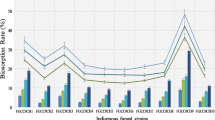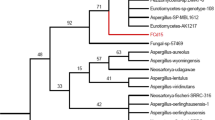Abstract
Wastewater particularly from electroplating, paint, leather, metal and tanning industries contain enormous amount of heavy metals. Microorganisms including fungi have been reported to exclude heavy metals from wastewater through bioaccumulation and biosorption at low cost and in eco-friendly way. An attempt was, therefore, made to isolate fungi from sites contaminated with heavy metals for higher tolerance and removal of heavy metals from wastewater. Seventy-six fungal isolates tolerant to heavy metals like Pb, Cd, Cr and Ni were isolated from sewage, sludge and industrial effluents containing heavy metals. Four fungi (Phanerochaete chrysosporium, Aspegillus awamori, Aspergillus flavus, Trichoderma viride) also were included in this study. The majority of the fungal isolates were able to tolerate up to 400 ppm concentration of Pb, Cd, Cr and Ni. The most heavy metal tolerant fungi were studied for removal of heavy metals from liquid media at 50 ppm concentration. Results indicated removal of substantial amount of heavy metals by some of the fungi. With respect to Pb, Cd, Cr and Ni, maximum uptake of 59.67, 16.25, 0.55, and 0.55 mg/g was observed by fungi Pb3 (Aspergillus terreus), Trichoderma viride, Cr8 (Trichoderma longibrachiatum), and isolate Ni27 (A. niger) respectively. This indicated the potential of these fungi as biosorbent for removal of heavy metals from wastewater and industrial effluents containing higher concentration of heavy metals.
Similar content being viewed by others
References
Donmez G, Aksu Z (2001) Bioaccumulation of copper (II) and nickel (10 by the non-dapted and adapted growing Cundidu sp. J Water Res 35:1425–1434
Peters RW, Young K, Bhattacharayan D (1985) Evaluation of recent treatment technique for removal of heavy metals from industrial wastewater. AICHE Symp Ser 81:1695–1703
Bai SR, Abrahim TE (2003) Studies on chromium (VI) Adsorption–desorption using immobilized fungal biomass. Bioresour Technol 87:17–26
Elizabeth KM, Anuradha TVR (2000) Biosorption of haxavalant chromium by non-pathogenic bacterial cell preparations. Indian J Microbiol 40:263–265
Gadd GM (1990) Fungi and yeast for metal accumulation. In: Ehrlich HL, Brierley CL (eds) Microbial mineral recovery. McGraw-Hill, New York, pp 249–276
Veglio F, Beolcmi F (1997) Removal of metals by biosorption: a review. J Hydrometall 74:301–316
Ahmad I, Ansari MI (2006) Biosorption of Ni, Cr and Cd by metal tolerant Aspergillus niger and Penicillium sp. using single and multimetal solution. Indian J Exp Biol 44:73–76
Arıca MY, Arpa C, Ergene A, Bayramog˘lu G, Genc O (2003) Ca-alginate as a support for Pb(II) and Zn(II) biosorption with immobilized Phanerochaete chrysosporium. Carbohydr Polym 52:167–174
Kapoor A, Viraraghavan T, Cullimore DR (1999) Removal of heavy metals using the fungus Aspergillus niger. Bioresour Technol 70:95–104
Sag˘lam Y, Yacınkaya Y, Denizli A, Arıca MY, Genc O, Bektas S (2002) Biosorption of mercury by carboxycellulose and immobilized Phanerochaete chrysosporium. Microchem J 71:73–81
Greenberg AE, Trussell RR, Clesceri LS (1985) Standard methods for the examination of water and wastewater, 16th edition edn. American Public Health Association, Washington, DC, pp 146–150
Solarsk S, May T, Roddick FA, Lawrie AC (2009) Isolation and screening of natural organic matter-degrading fungi. Chemosphere 75:751–758
Malik A (2004) Metal bioremediation through growing cells. J Environ Int 30:271–278
Rama Rao VSKV, Akhtar N, Maruthi MP (1997) Isolation of a cadmium tolerant Curvularia sp. for polluted effluent. Curr Sci 73:453
Li XM, Liao DX, Xu XQ, Yang Q, Zeng GM, Zheng W, Guo L (2008) Kinetic studies for the biosorption of lead and copper ions by Penicillium simplicissimum immobilized within loofa sponge. J Hazard Mater 159:610–615
Mittar D, Khanna PK, Marwaha SS, Kennedy JF (1992) Biobleaching of pulp and paper mill effluents by Phanerochaete chrysosporium. J Chem Technol Biotechnol 53:81–92
Say R, Denizli A, Arica MY (2001) Biosorption of cadmium(II), lead(II) and copper(II) with the filamentous fungus Phanerochaete chrysosporium. Bioresour Technol 76:67–70
Ahluwalia SS, Goyal D (2003) Removal of lead from aqueous solution by filaments fungi. Indian J Micobiol 43:237–241
Yetis U, Dolek A, Dilek FB, Qzcengiz G (2000) The removal of Pb(II) by Phanerochaete chrysosporium. Water Res 34:4090–4100
Melgar MJ, Alonso J, Garcia MA (2007) Removal of toxic metals from aqueous solutions by fungal biomass of Agaricus macrosporus. Sci Total Environ 385:12–19
Bishnoi NR, Kumar R, Bishnoi K (2007) Biosorption of Cr(VI) with Trichoderma viride immobilized fungal biomass and cell free Ca-alginate beads. Indian J Exp Biol 45:657–664
Liu Y, Fan T, Zeng G, Li X, Tong Q, Ye F, Zhou M, Xu W, Huang Y (2006) Removal of cadmium and zinc ions from aqueous solution by living Aspergillus niger. Trans Nonferr Met Soc China 16:681–686
Pogaku R, Kulkarni S (2006) Biosorption of combined industrial effluents using Phanerochaete chrysosporium. Int J Chem React Eng 4:A16
Morley GF, Gadd GM (1998) Sorption of toxic metals by fungi and clay materials. Mycol Res 99:1428–1439
Akar T, Tunali S (2006) Biosorption characteristics of Aspergillus flavus biomass for removal of Pb(II) and Cu(II) ions from an aqueous solution. Bioresour Technol 97:1780–1787
Gopal M, Pakshirajan K, Swaminathan T (2002) Heavy metal removal by biosorption using Phanerochaete chrysosporium. Appl Biochem Biotechnol 102:227–237
Preetha B, Viruthagiri T (2007) Batch and continuous biosorption of chromium(VI) by Rhizopus arrhizus. Sep Purif Technol 57:126–133
Congeeraram S, Dhanarani S, Park J, Dexilin M, Thamaraiselvi K (2007) Biosorption of chromium and nickel by heavy metal resistant fungal and bacterial isolates. J Hazard Mater 146:270–277
Mogollon L, Rodriguez R, Larrota W, Ramirez N, Torres R (1998) Biosorption of nickel using filamentous fungi. Appl Biochem Biotechnol 70:593–601
Acknowledgments
The authors are thankful to the Director, CSSRI, Karnal and Head, Division of Soils and Crop Management, CSSRI, Karnal for providing all the laboratory facilities for this work.
Author information
Authors and Affiliations
Corresponding author
Rights and permissions
About this article
Cite this article
Joshi, P.K., Swarup, A., Maheshwari, S. et al. Bioremediation of Heavy Metals in Liquid Media Through Fungi Isolated from Contaminated Sources. Indian J Microbiol 51, 482–487 (2011). https://doi.org/10.1007/s12088-011-0110-9
Received:
Accepted:
Published:
Issue Date:
DOI: https://doi.org/10.1007/s12088-011-0110-9




